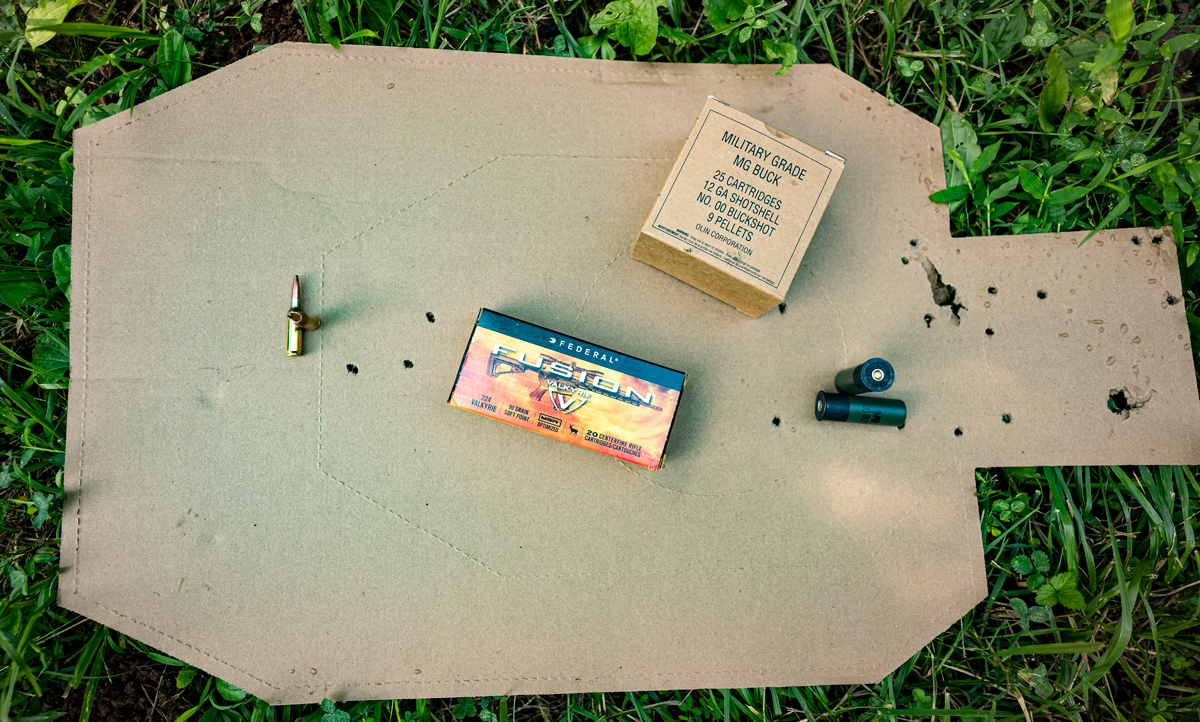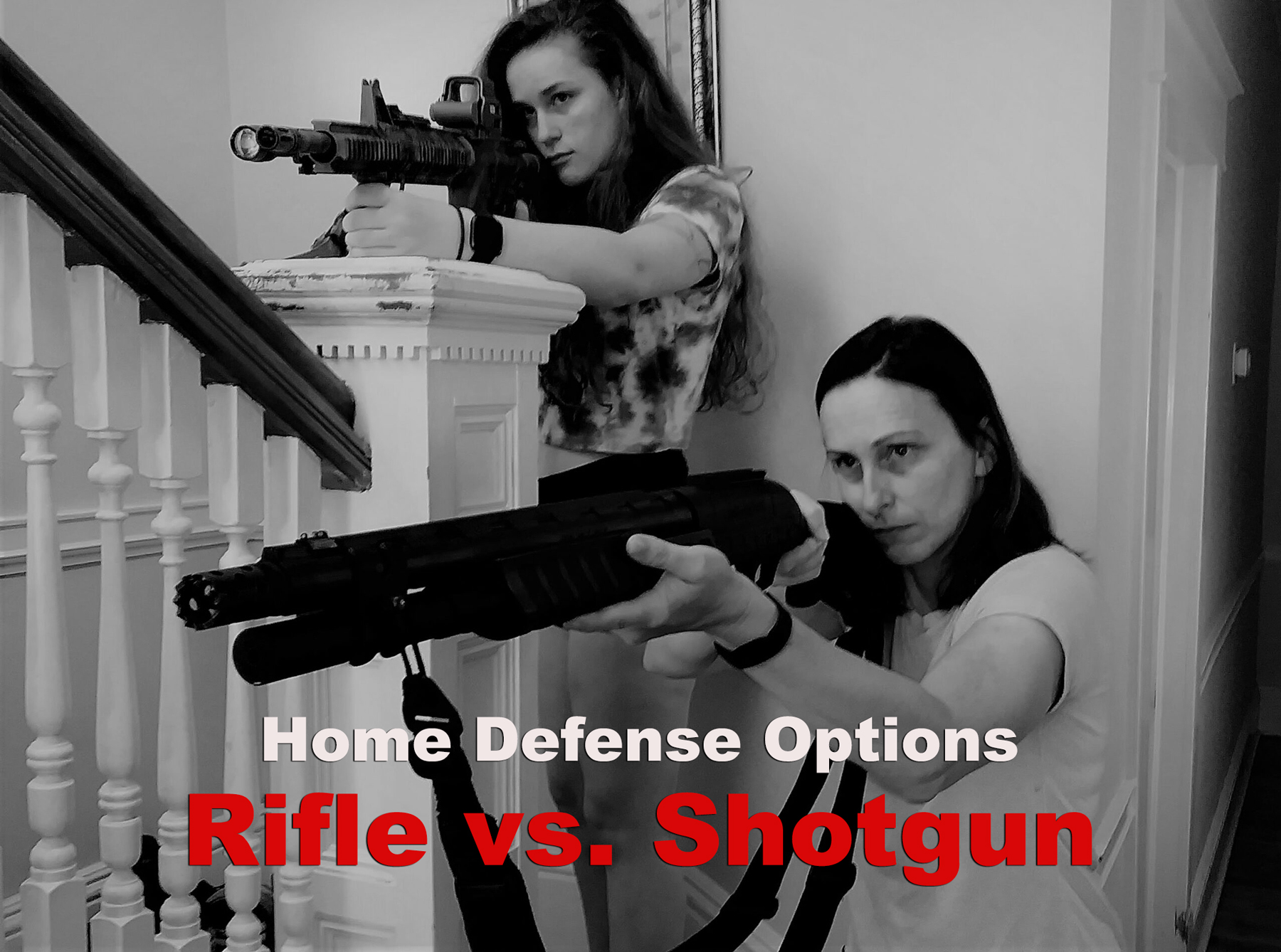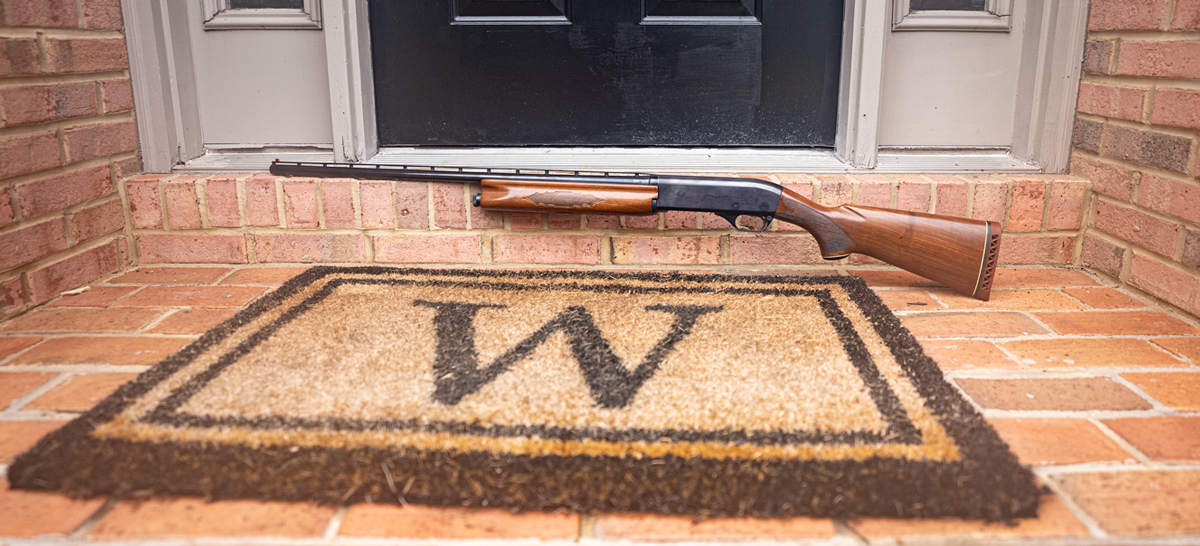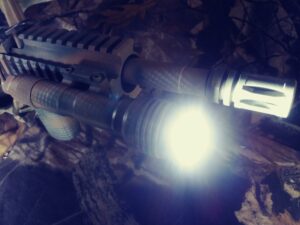A look at using shotguns and rifles for defending your home and family. Both options are popular, but which is best for your specific living situation? We can help.
Home defense guns may be one of the most hotly debated topics in the world of firearms. The subject has probably generated more arguments than politics (and that’s saying something with the way things are today). Everyone has their own opinion on the matter, and they are willing to passionately defend it. So, what’s the difference between a shotgun vs rifle and which is a better choice for you? Let’s dive in and find out.
Shotgun vs. Rifle
A shotgun fires a shotshell or buckshot. Sometimes called a scattergun, these firearms usually fire more than one projectile and spray a pattern into a target typically within 100 yards. A rifle is typically associated with greater distance and precision. It fires one bullet and can successfully hit a target up to several miles away.
What’s the best way to understand? This video can teach you the shotgun vs. rifle difference in 10 seconds.
Some shooters claim a shotgun is the perfect home defense weapon. (Even Joe Biden is a fan of the double barrel variety.) Others swear by a rifle for home protection.
The truth is, there is no one-size-fits-all home defense weapon. The “best” weapon for home defense depends on the situation, what you shoot most confidently, and the shooting skills of other family members who may need to use it.
Both platforms have benefits and limitations, and choosing one over the other is a major exercise in compromise. You just have to decide which compromises you’re willing to make.
Focusing on Home Defense
Plenty of shooters use their hunting, target shooting, or concealed carry gun as their primary home defense weapon. There’s certainly nothing wrong with your favorite firearm pulling double duty. If that’s the weapon you and your family are most comfortable using, have at it.
Don’t take the following information as criticism of your beloved sidearm or Grandpa’s deer rifle. We’re choosing to focus our attention here on picking a firearm whose primary function is protecting your home and family.
Shotguns for Home Defense
The good old-fashioned scattergun has been used to protect the homestead for generations. Many modern shooters still consider the shotgun the ideal home defense weapon.
There’s even the popular theory that the mere sound of racking a shotgun is enough to deter would-be criminals. It certainly takes an uncommonly brave idiot to stare down the barrel of a loaded 12-gauge and keep charging.
The shotgun has one major advantage over a rifle (and a handgun, for that matter): It has the ability to send a LOT of lead downrange in a hurry.
It can take multiple shots to eliminate a violent threat, especially if that threat is a person jacked up on narcotics or some other drug. That’s why most self-defense instructors emphasize getting multiple rounds on target as quickly as possible.
Unlike rifles or handguns, shotguns fire several projectiles each time you pull the trigger.
Load your home defense 12-gauge with 2 ¾-inch rounds of 00 buckshot (a common home defense choice – see our top picks for defensive 12 gauge ammo here), and you send nine .38 caliber balls of lead barreling toward your target with every trigger pull. If your goal is to get multiple projectiles on target fast, it’s hard to beat a shotgun.
And since most shotguns have a limited magazine capacity, and can be a challenge to reload, it’s a good thing each round contains so much lead.

Aiming a Home Defense Shotgun
There is a pervading myth that shotguns don’t need to be aimed. In this fairytale world, you can just point the shotgun, pull the trigger, and the rounds will magically find their way to your intended target.
Unfortunately, this belief is fairly common, even though it isn’t at all true.
That 2 ¾-inch round of 00 buckshot will produce a fist-size shot spread at 10 yards. Even at 20 yards, you won’t see a shot pattern much larger than a pie plate. While precision may not be as important with a shotgun as when you’re using a rifle, aiming is still essential, especially at the hallway-length engagement distance of the typical home defense situation.
While a cluster of 00 buckshot might not pass clean through a human intruder, miss that human intruder and that buckshot can punch through drywall and into the next room. Once it passes into the next room, it may still be carrying enough energy to do serious damage. Properly aiming a shotgun might not seem all that important until you consider the kids sleeping in that next room.
Sorry to burst your bubble, but you shouldn’t spray lead from a shotgun while holding it at the hip like they do in the movies. Even if Hollywood does make it look seriously cool and totally plausible.
You are responsible for every shot fired from your weapon. So raise that weapon to your shoulder and take careful aim before you pull the trigger.
Maneuverability
The standard sporting shotgun is long and heavy. While your duck hunting gun can definitely be used to thwart home intruders, the extra-long barrel and hefty weight can be a huge hindrance in close quarters conditions (like your hallway or living room).
If you want a dedicated home defense shotgun, a tactical shotgun with a shorter barrel (typically between 18.5 to 20 inches) will be far easier to maneuver indoors. Some tactical models also come with extended magazine capacity and enhanced sights.
The Issue of Recoil
That cluster of 00 buckshot does some serious damage to soft tissue, especially at close range. Each pull of the trigger delivers some major stopping power. However, that power comes with a price. The average 12-gauge can produce some pretty serious recoil.
Not only can recoil put a hurting on your shoulder, it can make it harder to recover from that first shot, and recovery is key to getting the bead back on target for accurate follow-up shots.
While you might think the recoil is no big deal, it can be a major issue for small-frame shooters or anyone with limited upper body strength. What happens if your wife, teenage daughter, or elderly mother is confronted by a home intruder? Will she be able to fend off an attacker with your home defense shotgun?
If you’re still dead-set on using a shotgun, choose loads specifically designed for home defense. Most are designed to produce less felt recoil.
Shotgun Pros and Cons
Let’s sum it up in a quick review.
The Pros
- Fires multiple projectiles with each shot.
- Serious stopping power.
- Staring down the barrel of a 12-gauge is pretty threatening (not to mention that ominous pump action sound).
The Cons
- Heavy and long.
- Harsh recoil.
- Limited magazine capacity.
- Difficult to reload.
- 00 buckshot can penetrate walls.
Rifles for Home Defense

If you have to investigate something that goes bump in the night, it’s probably best to leave that bolt action rifle you use to hunt mule deer in the gun safe. Not only will it be slow to load, the high-power cartridges it shoots produce excessive flash, noise, and recoil. That’s a disorienting (and dangerous) combination for the shooter, especially inside a dark house.
Your hunting rifle also fires projectiles that travel at high velocities and carry a ton of kinetic energy. While those are a bonus when shooting big game in open woods, they create major penetration issues inside your home.
The soft points you use for mulies are likely to over penetrate your target at close home defense ranges. And once they penetrate your target, they’ll keep going through the wall behind the target, and probably the wall of your neighbor’s house down the street. Remember, you are responsible for every shot fired from your weapon.
The AR-15 for Home Defense
That doesn’t mean no rifle is a viable option for home defense. While your bolt action .308 may not be practical, that doesn’t mean your modern sporting rifle isn’t. In fact, when it comes to home defense, we’re big fans of America’s sweetheart rifle, the AR-15.
While the sharp corners and tight confines of the average family home make maneuvering a long gun problematic, the carbine length AR-15 was built for these conditions. It’s also lightweight, easy to shoot, and has only mild recoil (especially in the most common chambering of .223/5.56).
It also has a magazine capacity that puts the typical shotgun to shame. The standard AR magazine holds thirty rounds. If you live in California, Colorado, Connecticut, Hawaii, Maryland, Massachusetts, New Jersey, New York, Vermont, or the District of Columbia, the law limits your magazine to 10 rounds. That’s still five more rounds than the average sporting shotgun.
Considering Other Family Members
The AR-15 is surprisingly easy to shoot, especially for inexperienced shooters. Although there have been plenty of pundits and politicians who have attempted to paint the AR-15 as a frightening weapon of mass destruction, it actually makes a great entry-level weapon for new shooters.
The combination of the weapon’s ergonomics and soft-shooting caliber make the AR-15 easy to shoot accurately and confidently, even if you’re an infrequent shooter.
Its short barrel-length and light weight also make it easy for younger or elderly shooters to handle. While I may be fine with a hefty 12 gauge, I’d prefer my 16 year-old daughter or my 70 year-old mother have an AR in their hands if a violent criminal threatens them when they’re home alone. It’s just going to be easier for them to put multiple rounds on target with that weapon compared to the heavy and hard-hitting 12 gauge.
Upgrading Your AR-15 for Home Defense
I have often said AR-15s are like Barbie dolls for grown-ups. (Sorry, guys.) Just like with Barbies, the real fun is in accessorizing them. With user-friendly rail systems and tons of aftermarket support, you can add pretty much anything you want to your rifle.
If you want to use your AR-15 for home defense, you can choose lights, lasers, and optics that make these easy-shooting weapons even easier to shoot.
Worried about seeing in the dark? Add a flashlight.
Need an intuitive optic for an inexperienced shooter? Pop a holo sight or a red dot on your rail.
Worried about disorienting muzzle flash inside a dark house? Use a flash hider.
The possibilities for customizing your AR-15 are endless.
Home Defense Ammo for Your AR-15
Another advantage of using an AR-15 is that there is a ton of ammo on the market. .223/5.56 ammo is relatively inexpensive and usually readily available.
Because the AR-15 is easily the most popular civilian rifle in the world, you can find a load optimized to meet pretty much all your shooting desires. If you want cheap practice ammo, it’s easy to find. Want match grade competition ammo? There’s plenty of that, too.
There’s even ammo designed specifically for home defense. Some of these specialized loads feature reduced flash propellants, nickel-plated cases for easy chamber checks, and expanding bullets intended to stay in the target.
Expanding projectiles dump a ton of energy into the target, preventing dangerous over-penetration. Expansion also slows the projectiles when they strike a wall, minimizing the risk of them punching through to the room where your family is hiding.
AR-15 Pros and Cons
Here’s a quick summary of the pros and cons.
The Pros
- Higher magazine capacity.
- Easier to shoot, especially for weaker or inexperienced shooters.
- Mild recoil.
- Light weight and carbine length barrel makes it easier to maneuver indoors.
- Easy to customize with accessories.
- Less chance of over penetration, especially with the proper ammo.
The Cons
- Less tissue damage per round.
The Importance of a Plan
Whatever you pick in the rifle vs shotgun debate, don’t neglect training and good old-fashioned practice. Both will help improve your confidence and accuracy with the weapon.
You should also have a plan in place for what to do in the event of a home intrusion. It should include paths of retreat as well as plans for engagement. The plan doesn’t need to be elaborate, and it certainly won’t be perfect. However, having even a basic strategy will put you leagues ahead of most American households.
Be sure to share both weapon training and your home defense plan with all the members of your family.
Final Thoughts
We’ve chosen to focus our attention on shotguns vs modern sporting rifles in this article on home defense. We know there are other options, but space here is limited. Feel free to share your experiences and/or opinions in the comments.



